
Deposition Date
2019-06-10
Release Date
2020-08-12
Last Version Date
2024-11-06
Entry Detail
PDB ID:
6RY6
Keywords:
Title:
Crystal structure of Dfg5 from Chaetomium thermophilum in complex with glucosamine
Biological Source:
Source Organism:
Host Organism:
Method Details:
Experimental Method:
Resolution:
1.30 Å
R-Value Free:
0.12
R-Value Work:
0.11
R-Value Observed:
0.11
Space Group:
C 1 2 1


